Aviation against tanks (part of 19)
In the 70-80-ies, the armed forces of the European countries of NATO had anti-helicopter helicopters, created on the basis of light helicopters of general purpose. Such helicopters, armed with anti-tank guided missiles, were relatively inexpensive in production and operation, had good maneuverability and small size. But at the same time, "Alueta", "Gazelle", In 105 and "Lynxes", who did not have armor, were very vulnerable to combat damage and could be knocked down even by light from small rifle fire. weapons. It is clear that, faced with a Soviet-style modern front-line air defense system, anti-helicopter helicopters that do not have armor protection and special technical solutions to increase security and duplicate components and assemblies would have insufficient combat survivability.
The first problem was attended by the British. The British Rhine Army deployed in Germany was considered, along with the American contingent, the most combat-ready part of the NATO forces in Europe. Until the second half of the 80-x, the only Western serial type of combat helicopter equipped with armor was the AN-1 Cobra, and in the absence of another alternative, the British considered the acquisition of the twin-engine AN-1W Super Cobra, armed with an AGM-114 laser guided laser Hellfire and heavier air-to-ground missiles AGM-65 Maveric.
According to the requirements formulated by the British military, Bell Helicopter has created a modification of the AN-1V Venom. The Venom was in many ways similar to the AN-1W model and had a four-blade propeller with increased lifting force, borrowed from the civilian Bell 412. The helicopter, created by British order, could accelerate to 310 km / h, and was equipped with equipment enabling operation in conditions of poor visibility at night, as well as inertial navigation system of British manufacture. In general, the car turned out to be quite good; the AN-1Z combat helicopters with similar characteristics are still operated in aviation ILC United States. But due to budgetary constraints, the purchase of a rotary-wing attack aircraft in the United States hovered in mid-air, and the British subsequently acquired more advanced Apaches.
Strangely enough, but the first to raise the issue of creating a "European" combat helicopter was the Italian military. After the end of World War II, the Italian Air Force was equipped mainly with American-made equipment or manufactured under an American license at local enterprises. At the same time, Italy had a number of original developments of its own, for example: Aermacchi MB-326 and MB-339, which were also used as light attack aircraft and fighter-bombers Aeritalia FIAT G.91.
In 1976, deliveries of the Agusta A.109 Hirundo helicopter began. The machine, created by experts of the firm "Agusta", immediately attracted attention. Thanks to the licked aerodynamic shape and high specific power of the engines, the speed of the “Hirundo” surpassed most other machines of the same class. The supply of fuel on board allowed 7 passengers to be transported with a cruising speed of 265 km over a distance of 600 km. The helicopter was popular in Italy and among foreign buyers and had several serial modifications, different composition of avionics and power plant.
Military variant with retractable chassis A.109E. equipped with two Pratt & Whitney Canada PW206C engines with a total takeoff power of 1280 hp. A helicopter with a maximum take-off weight of 2850 kg could take 1180 kg of cargo. The maximum speed in level flight is 311 km / h. In June 1981, the A.109A modification set the world climb record.
Shortly after the start of mass production of Hirundo, Agusta, together with the American Hughes Aircraft Company, began work on a specialized anti-tank variant equipped with an ATOW TOW, the M65 sighting system (the same sight was mounted on the American AH-1S) and a partially armored cabin. Various modifications of the A.109, differing from each other in engines and instrument equipment, could carry 4 anti-tank missiles, NAR, automatic 40-mm grenade launchers, machine guns and 20-mm guns. Belgium became the first official customer of the Agusta combat helicopters. A109 gathered in Belgium at the enterprises of the company SABCA. The Belgian army received an 28BA 109 anti-tank helicopter.
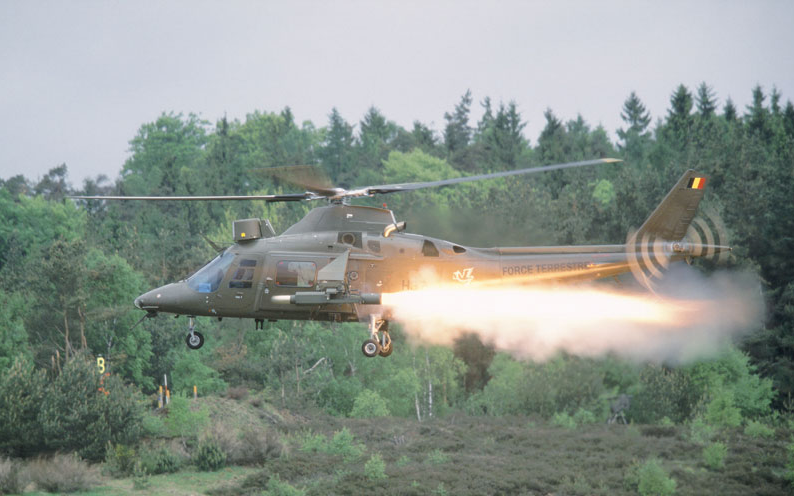
In the middle of the 80, the Italian military ordered an 24 A.109ЕОА with two Allison 250-C20R engines with an 450 power. with. The SFIM М334-25 sights and CILAS laser rangefinders were mounted on helicopters, and a wide range of weapons was mounted on external pylons. The weight of the combat load on the external nodes could reach 370 kg. On the part of the machines, machine guns were mounted in doorways. A.109EOA could be used for a wide range of tasks, but in the role of anti-tank because of its weak protection it was still not as effective as specialized combat helicopters with armor.
In the 80-90 years, several more armed modifications appeared, created in accordance with the specific preferences of the customer. Success on the international arms market was the modification of AW109Е LUH (Light Utility Helicopter - rus. Light service helicopter). The helicopter is equipped with Avionics with an “open architecture” into which modern navigation, aiming-search and night-vision systems can be easily integrated. The night vision equipment is located in the nose of the AW109Е LUH, and the sighting and sight complex sensors are located above the cabin.
Engines of various manufacturers, American or European sighting and navigation systems, ATGM TOW or NOT were adapted for A.109 helicopters. At the Hirundo, delivered to Argentina, local experts installed the Mathogo ATGM. This wire-guided missile with a launch range of up to 3000 m is recognized on the basis of the Swedish Rb 53. In the UK, after the merger of Agusta and Westland in 2000, an option was tested, armed with AGM-114 Hellfire missiles with a laser seeker. A number of buyers preferred helicopters with fixed gear. Although this seriously reduced speed data, in the event of an emergency landing, the chances of survival of the crew and passengers were higher.
Despite the relatively high flight data and active advertising, “Hirundo” for military purposes was not widely used. This is largely hampered by the high cost of the machine. In the 2000, for a helicopter equipped with ATGMs and a modern aiming-search system, they asked for $ 8 million, while the upgraded Bo 105 PAH-1А1 with PTOW TOW was offered $ 2 million cheaper. Approximately 700 A-109 of all modifications has been built at the moment, and only about 10% of them could carry anti-tank missiles.
After a successful debut with A-109, Agusta, commissioned by the Italian Ministry of Defense, began the development of a two-seater combat helicopter. The design of the new machine was based on the already existing units and aggregates of "Hirundo". It was quite obvious that in the conditions of tough competition with American-made helicopters, the specialized anti-tank Italian machine has few chances to be successful in the external market, even among European allies in NATO. An example of this is the Aeritalia FIAT G.91 light fighter-bomber, which is very good for its time, surpassing many of its American and British peers by the “cost-effectiveness” criterion, but not adopted anywhere except in Italy, the FRG and Portugal.
Wanting to share the burden of costs, the Italians planned to develop a new combat helicopter together with Germany. In 1975, Agusta and Messerschmitt-Bölkow-Blohm entered into an agreement to begin joint work on the project under the preliminary name A-MBB. 115. However, the partners soon disagreed on the technical appearance and capabilities of a promising machine. The Italian military, very financially constrained, wanted a relatively inexpensive armored version of the multi-purpose A-109, and the Germans, who would have been the first to face the Soviet in case of war tank armies, wanted to have an anti-tank helicopter, comparable in its characteristics with the Apache being created in the USA.
After the Germans left the joint project, the Italian military was going to curtail the program of creating their own combat helicopter and acquire the American Cobras. Moreover, the Italian armed forces, even according to the most optimistic estimates, could not buy more than 80-100 machines, which made the development of a combat helicopter from an economic point of view unprofitable. However, apparently, the management of Agusta managed to lobby the government for continued financing, and received guarantees that, if the program was successful, the helicopter would be purchased by the Italian army. In fairness, it should be said that after the creation of the Hirundo, the Agusta company was on a technological and financial upsurge, and there was every reason to believe that in fact, on the basis of the A.109 helicopter, you can create a good anti-tank machine. Also on the side of Agust were national financial bigwigs, since in the case of the purchase of American combat helicopters the money would have left the country. The government, in turn, wanted to provide jobs and raise the scientific and technological level of its industry. Thus, despite the low profitability of the project, it was continued. Of course, the Italians failed to create a car comparable in their capabilities and security with the American Apache or the Soviet Ka-50 and Mi-28. But the helicopter of national development largely reflected the views of the Italian military on what should be a light anti-tank helicopter, which was to operate in the specific conditions of Southern Europe, where mountains and hilly hills coexisted with valleys rugged river channels.
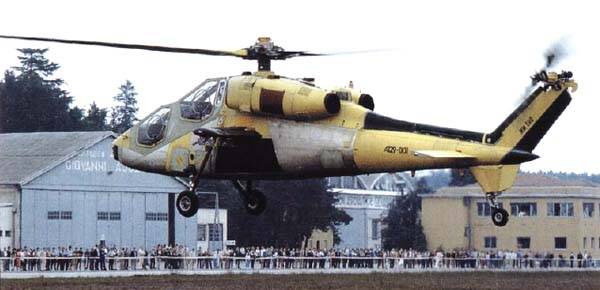
Flight tests of the helicopter prototype, later designated A.129 Mangusta, began in September 1983. In May, 1985, the third prototype rose into the air, equipped with a full set of avionics and weapons. In total, five prototypes were built for testing, their total flight time was about 1600 hours.
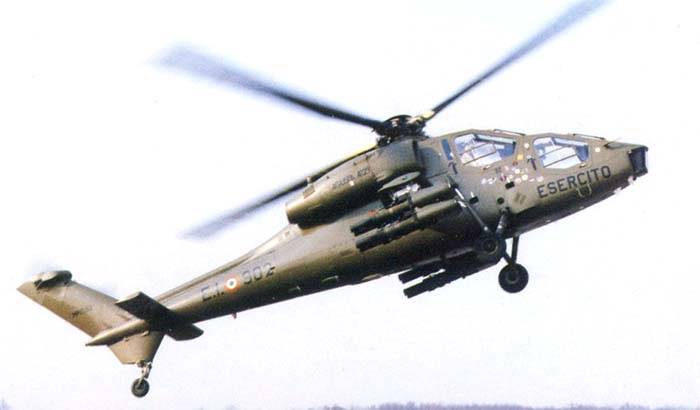
After the sixth pre-production copy was built and tested for military tests, at the end of 1986, it was decided to order an 15 anti-tank A.129 helicopters. But the practical implementation of the adoption process has been delayed. The military, who already within the framework of cooperation and information exchange within the NATO bloc managed to familiarize themselves with the capabilities of the American Apache, were not satisfied with the fact that A.129 could act only during the day and in good weather. The command of army aviation wanted to get a helicopter that can effectively deal with tanks in the dark and in poor visibility conditions. As a result, the Mongoose was not only one of the first specialized anti-tank helicopters that was designed in Europe, but also the first helicopter in the world to use the 1553В digital data bus, which allows for automation of management functions and reducing the load on the crew. The data transmission and processing system provides interconnection between all components of electronic equipment, including radio and navigation equipment, power distribution and power plant control, operation of flight control systems and increasing stability, as well as weapon control.
In parallel with the modern data processing system, the first serial modification of A.129А in order to accelerate the adoption of the machine into service was used a rather old American gyrostabilized guidance system of anti-tank missiles М65. The sight, mounted in the nose of the fuselage, has two fields of view: wide - with an angle of 30 ° and double magnification, which is used to search and detect a target, and narrow - with an angle of 4,6 ° and 13-fold increase - for recognition and tracking of the target, as well as guidance ATGM. To enable the use of weapons and piloting in the dark, on the same platform with the М65 sight, a PNVS (Pilot Night Vision System - Russian flight system of night vision) and laser range finder are mounted. The crew has a helmet-mounted sighting system IHADSS (Integrated Helmet and Display Sighting System - Rus. Integrated helmet and display control system) used for aiming, piloting the helicopter and displaying information). To reduce the vulnerability of the helicopter from air defense systems and fighters, it was planned to install American radar AN / APR-39 radar and laser AN / AVR-2 radar detectors and AN / ALQ-136 and AN / ALQ jammers at the design stage. -144 and devices for ejecting radar reflectors and IR traps.
Since the development and adaptation of onboard electronic equipment was delayed, the first helicopters A.129A entered the troops only in 1990 year. The total order amounted to 60 machines.
The combat helicopter A.129A was quite light. With a maximum take-off weight of 4100 kg, with two Rolls-Royce Gem 2-1004D hp take-off engines. each, he could reach speed in horizontal flight 704 km / h. However, in order to save resources and for security reasons, on combat vehicles it was forbidden to reach speeds of more than 280 km / h. Rate of climb: 260 m / s. Maximum operating overload: + 10,2 / -3,5 g. The range can reach 0,5 km. A typical combat mission with four ATGMs and two NAR units consisted of flying at low and extremely low altitudes to the 400 km range, looting during the 100 minutes in the waiting area, launching an ATGM and returning to the base. Instead of armament, outboard fuel tanks can be installed on external nodes, and the ferry flight range is 90 km.
On the first modification of A.129A Mangusta there was no movable turret with small-arms armament. The helicopter could take 8 ATGM or 76 70-mm NAR or 38 81-mm NAR. At first, it was planned to install the modernized French anti-tank missiles HOT-2. But because of the problems with the reliability of the ATGM NOT and the decision already taken to use the American guidance system M65, the “main caliber” became the ATGM BGM-71 TOW. The load capacity of the external armament suspension nodes exceeds 1000 kg, however in a typical combat departure the weight of the weapon along the sides of the helicopter is no more than 500 kg.
Initially, in the Italian military helicopter did not use guns at all. According to the concept of use of A.109, adopted by the Italian armed forces, helicopters were to launch rocket attacks from a distance exceeding the effective range of anti-aircraft weapons, and then quickly retire. However, participation in a number of local conflicts revealed the need for machine gun weapons on board. Beginning with the 1997 of the year, suspension containers with 109-mm machine guns are mounted on the A.12,7.
The downside of the relatively small size, low weight and good maneuverability of the Italian "Mongoose" was the worst security compared to modern foreign counterparts. The helicopter’s design has introduced standard requirements for machines of this class to duplicate and increase the survivability of the main components and assemblies, the helicopter’s armor can only hold armor-piercing bullets with a caliber of no more than 12,7-mm released from the 400 distance. Although the four-blade propeller was initially required after lumbar 23-mm projectiles, in practice, managed to guarantee only safe lumbago 12,7-mm bullets. Cabin flat glazing is designed to protect against rifle bullets. Nevertheless, the leadership of the Italian Ministry of Defense considered the flight and combat characteristics of A.129A Mangusta quite satisfactory. In addition, by the time the Mongoose entered the combat squadron, the threat of a full-scale military conflict in Europe had become extremely unlikely.
The helicopters entered service with the 48 group of the Pavoni and 49 group Kaprikorno helicopters. In the middle of 1996, as part of the military reform of the Italian armed forces, both groups brought together the Bega helicopters in 7.
Currently, the main base for the 7 air regiment is the Rivolto air base in the region of Casarsa della Delizia. Here along with A. 129 are placed A. 109 and NH90. However, the intensity of flights A. 129 in recent years is low, and they are mostly idle at the stands or covered inside the hangars. It is reported that digital 3-D simulators are used to maintain flight skills.
In 1993, three A.129А were involved in the peacekeeping operation in Somalia. “Mongoose” was delivered to Africa by sea, the base of the helicopters was Mogadishu International Airport.
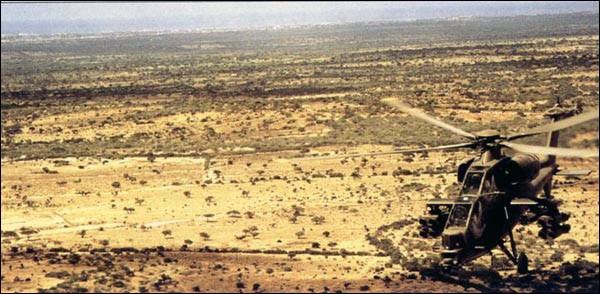
The main tasks of A.129А were the escort of unarmed helicopters and air cover of ground columns. On several occasions, Italian combat helicopters participated in repelling rebel attacks on peacekeepers' checkpoints. After a series of attacks and attacks on the garrison of the Italian contingent, A.129A helicopters destroyed several pickups and trucks with mortars, recoilless guns and anti-aircraft guns in the area of responsibility of the Italians. Flights were performed both during the day and at night. After the discovery of armed insurgent vehicles, he was destroyed by anti-tank missiles and the NAR. The pilots of the helicopters tried not to enter the zone of effective fire anti-aircraft machine guns. However, during the Mongoose combat sorties, 7,62 and 12,7-mm caliber bullets were hit several times, but this did not lead to serious consequences. The pilots of A.129A noted the redundancy of the helicopter’s weapons for most of the tasks carried out in Somalia. In a number of combat situations, there was an acute shortage of small arms and gun armament aboard the Mongoose, armed only with guided missiles and 81-mm NAR. For example, A. XNUMHA could not use his powerful weapons when the enemy was too close to the peacekeepers, or when there was a risk of civilian destruction. In this regard, combat missions were often performed in conjunction with AV.129 helicopters armed with suspended machine-gun containers.
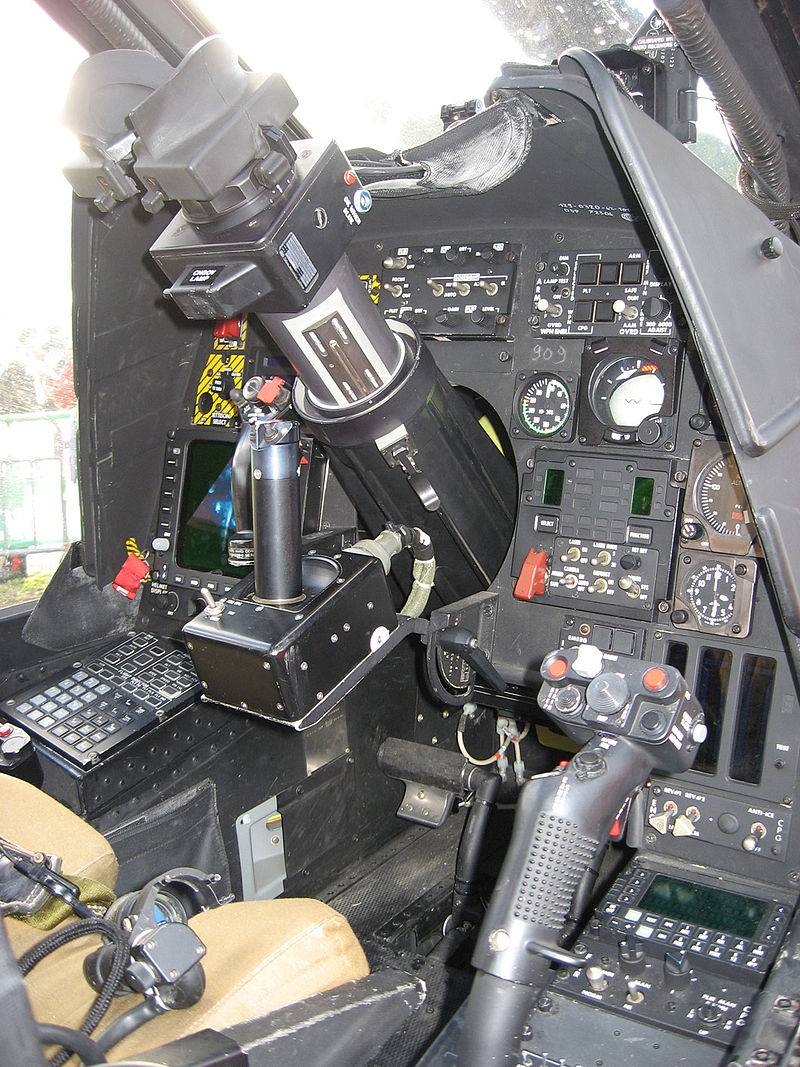
In the event of the discovery of armed rebels in the exclusion zone, A. 129А, fixing them with his search and aiming system, directed a helicopter with machine-gun armament. In total, during the first phase of the operation, A. 129A’s peacekeepers made 878 sorties, spending hours in the 844 air.
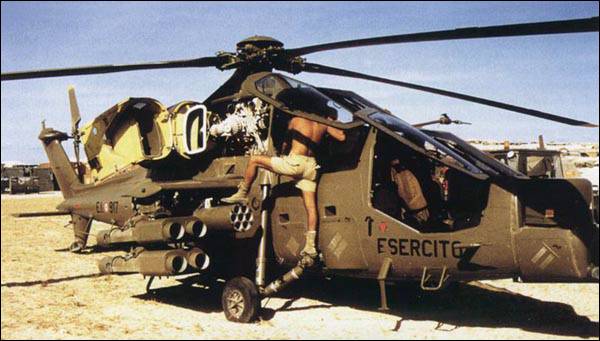
During operation in Somalia, ground staff had to make considerable efforts to maintain a sufficiently delicate Italian equipment in working condition. Only in a combat situation, it turned out that night-vision goggles are incompatible with instrumentation equipment, and navigation equipment gives a large error.
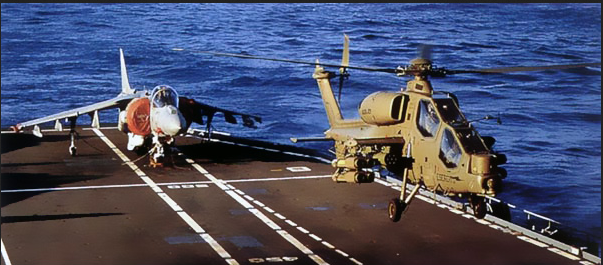
In the first half of 1994, four “Mongooses” covered the withdrawal of peacekeepers from Somalia. The helicopters operated from the deck of the aircraft carrier Giuseppe Garibaldi and flew 162 hours. For the basing of A.129A on the ship, the system of folding main rotor blades was modified, which made it possible to store the helicopters in a deck-mounted hangar.
In 1994, the delivery of the first series of A.129А was completed, and in 1996, the second. In 1997, the construction of cars of the third series began. In total, for the Italian Army Aviation, without taking into account the six experimental machines, the 60 serial "Mongoose" was built. Machines of the third series after the merger of Agusta and Westland in 2007 year received the designation AW129. Construction of attack helicopters of the third series AW129D was carried out immediately on a radically revised version with improved avionics and a gun turret.
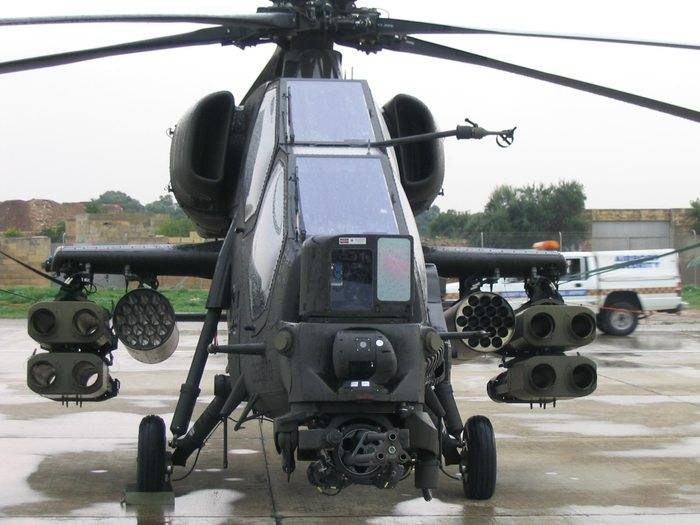
The most noticeable external difference between the AW129D version and the A.129А was the five-blade main rotor and the turret with a three-barreled 20-mm Oto-Melara 197B gun (the American М197 version). In connection with the installation of the gun, the FLIR night vision system and the Rafael Toplite III sighting and search equipment, the nose part of the fuselage has undergone significant changes.
This made it possible to use Israeli Spike ER and AGM-114 Hellfire missiles, as well as other laser-guided aviation munitions. In addition, significantly increased the accuracy of firing from the gun and the NAR. However, judging by the recent photographs of the Italian drill helicopters of the A.129 family, they still use the old American M65 and BGM-71 TOW ATGM sights, which are most likely due to budget constraints.
For timely detection of anti-aircraft launches and air-to-air missiles, the modernized Mongoose installed optoelectronic sensors of AN / AAR-60 equipment, radar radiation warning receivers Elettronica ELT-156 and RALM-101 laser irradiation. Elettronica ELT-554 and BAE Systems IEWS AN / ALQ-144A systems are designed to set up interference in the radar range and rockets with infrared guidance.
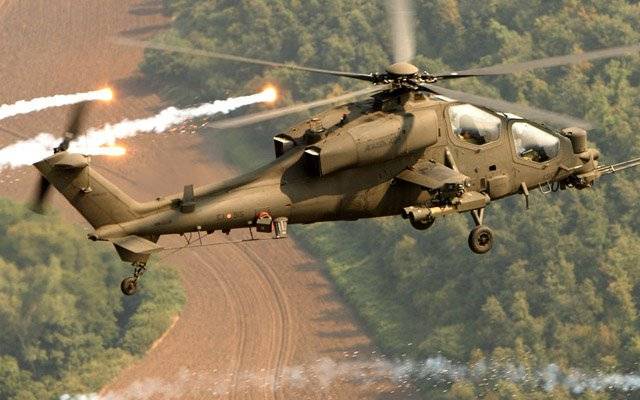
The last line of passive defense against missile defense and air-to-air missile defense systems is the automatic shooting of heat traps and dipole reflectors. Thermal visibility of engines is reduced due to the installation of new nozzles on exhaust manifolds, which, before releasing heated gases into the atmosphere, mix them with cold air.
The flight characteristics of the updated helicopter were improved through the use of new Rolls-Royce / Turbomeca RTM 322 turboshaft engines with 890 hp power. At the same time, the maximum flight speed increased to 300 km / h, but in peacetime the speed is limited to 278 km / h. Rate of climb was 11,3 m / s. Maximum take-off weight reached 4600 kg. If you believe the advertising data of the manufacturer, the combat range exceeds 500 km.
Operation in hot spots showed that the helicopter needs careful ground maintenance, even the digital diagnostic system did not help. After a mission in Somalia, the designers made a lot of effort to reduce labor costs during the preparation of the upgraded helicopter for the sortie. Special attention was paid to the convenience of access to components and assemblies and their protection from dust and sand.
Based on the experience of combat use, the helicopter not only introduced the turret gun mount, but also increased security. The new five-lobe mainframe of increased efficiency withstands lumbago 23-mm armor-piercing projectiles. The transmission is able to maintain performance for half an hour without lubrication and allegedly withstands hitting single 12,7-mm bullets. The security of the cockpit from the inside is enhanced by an anti-splinter lining of several layers of polymer ballistic fabric.
The upgraded A.129CBT helicopters provided air support to the Italian military contingent in Iraq and Afghanistan. In general, the "Mongoose" proved to be not bad. It was noted that in terms of flight data, security and firepower, the Italian combat helicopter roughly corresponds to the American A-1Z Viper, which is in service with Aviation KMP USA. But at the same time, the cost of a new Italian combat helicopter is significantly higher than that of an American vehicle. In 2012, the AW129D cost the Italian Ministry of Defense $ 53 million, while the A-1Z Viper cost $ 31 million at the same time. The higher price of the Mongoose is associated with a relatively small number of machines built, while the A-1Z Viper was built on the basis of the widespread "Super Cobra".
At the moment, most of the "Mongoose" of the first series is written off due to the full development of the resource. According to The Military Balance 2017, there are 59 combat helicopters in the Army Air Force of the Italian Army: 9 A.129A and 50 A.129CBT. Apparently, the new AW129D and the upgraded second and third A.129A series are included in the A.129CBT number. In turn, part of the upgraded helicopters A.129A received only the FLIR night vision system and a new transmission. The engines and most of the on-board electronics remained the same. It is expected that the modified A.129CBT will be in service until the 2025 year.
On the basis of A.129, the T-1997 ATAK (Attack and Tactical Reconnaissance Helicopters - Rus. Tactical reconnaissance tactical helicopter) was created for participation in the tender announced by Turkey in 129. In addition to Agusta Westland, the European consortium Eurocotper, the American corporations Bell Helicopters and Boeing, and the Russian company Kamov participated in the competition. The competition itself was accompanied by a series of scandals, the Turks repeatedly changed the requirements for the helicopter and for the composition of the avionics and weapons. Already during the tender, the announced amount of the contract and the number of helicopters purchased were reduced.
In 2000, AH-1Z of the American company Bell Helicopters was declared the winner of the competition. However, soon the Turkish side began to demand the establishment of licensed production in itself and the transfer of a number of secret technologies. In this case, the customer was willing to pay for the construction of only 50 machines, stretching the payment process for 5 years. After heavy negotiations, which lasted for several years, the management of Bell and the American government considered such conditions unacceptable, and the deal fell through. This happened despite the fact that at that time there were about four dozen “Cobras” of modifications in the composition of the Turkish army aviation: AH-1S, AH-1P, AH-1W. Apparently, the Turks decided to repeat the focus, which they succeeded with the F-16 Fighting Falcon fighter jets. At the enterprises of the Turkish company TAI (Turkish Aerospace Industries) the F-16 Fighting Falcon Block 50 fighter is being assembled. The desire of the Turkish leadership not only to buy modern combat helicopters for little money, but also to gain access to modern aircraft technology has impacted on the US-Turkish military-technical cooperation and ruined relations with American aircraft manufacturers.
As a result, the British-Italian company Agusta Westland won the disruption of the US-Turkish deal, which concluded a contract for the supply of an 7 combat helicopter to 2007 in September of 51. According to the terms of the first part of the contract, worth $ 1,2 billion, the licensed assembly of T-129 helicopters was established at the TAI plant in Turkey. Launch of LHTEC CTS800-4A engines with HP 1361 take-off power should be carried out at the plant of the Turkish company Tusaş Engine Industries (TEI). The production of the AselFLIR-300T thermal imaging sighting and surveillance system and the AVCI helmet-assisted target designation system should be handled by the Turkish company Aselsan. In July, 2012 was announced the creation and successful testing of the Turkish millimeter-wave radar MILDAR, which, according to its characteristics, is allegedly not inferior to the AN / APG-78 Longbow radar.
The main weapon of the T-129 was to become a Turkish-made ATGM UMTAS (Uzun Menzilli Tanksavar Sistemi - Russian. Long-range anti-tank system). The rocket, known as Mizrak-U / L, was developed by the Turkish company Roketsan using the AGM-114 Hellfire ATGM technical solutions. On a combat helicopter modifications T-129V 8 ATGM Mizrak-U / L can be suspended.
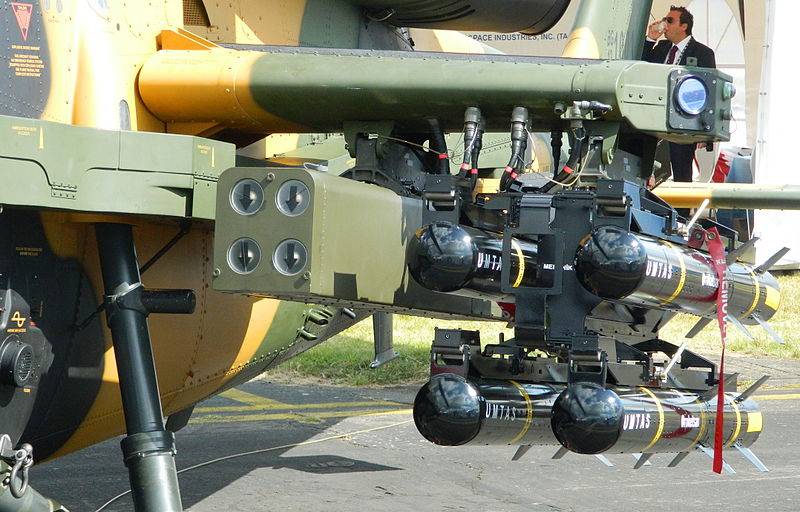
The Mizrak ATGM with a tandem warhead is guided by a laser or with the help of an IK GOS operating on the “shot and forget” principle. The launch range was up to 8000 m. However, the missile development and tests were delayed, and the deliveries of the ATGM of the serial assembly began only in the first half of the 2016 year.
On the basis of 70-mm NAR Hydra 70, Roketsan created and manufactured Cirit. The main element of the Cirit rocket is the control unit installed on the NAR. When converting an unguided missile into a high-precision aviation ammunition unit with electronics, steering wheels and a laser seeker mounted on the head of the NAR Hydra 70. Depending on the planned combat mission, the rocket may carry a cumulative, high-explosive fragmentation or incendiary warhead. For the use of CIR, a special quadruple "smart" launcher has been developed, which allows the helicopter's onboard equipment to communicate with the UR control system and monitor it until it leaves the track. According to the stated data at a distance of 8000 m, the rocket is capable of striking objects of size 3x3 meters. The Cirit missile launched into service in Turkey in 2011.
The exact flight characteristics of a T-129 ATAK combat helicopter are unknown and contradictory in various sources. According to information provided by Agusta Westland, the developer, a helicopter with a maximum take-off weight of 5000 kg can develop 278 km / h in horizontal flight. Rate of climb is 14 m / s. Ceiling - 6000 m. Fighting radius - Bole 500 km. A number of aviation experts expressed surprise that the maximum flight speed of the T-129A, equipped with engines with a total power of about 4000 hp, corresponds to the maximum flight speed of the modernized A.129, although the powerplant of the Italian helicopter is significantly lower.
At the end of September, 2009, Italy, began testing the first prototype of the T-129Р-1. In 2010, the first prototype suffered an accident due to a fault in the tail rotor, in which no one was injured. In August, the prototype T-2011Р-129, built in Turkey, took off for the first time in August 6. In 2013, troop tests of the first production machines began. It turned out that the helicopters of the serial assembly do not correspond to the declared characteristics. Due to the fact that Turkish-made sighting and search equipment, located in the forward part of the fuselage, turned out to be heavier than planned, in order to maintain the balance on the 137 kg, the weight of the tail boom was increased. In flight at high speed, the vibration level was too high, the helicopters of the first batch could not reach the maximum flight altitude set by the project. During the flights in the highlands, it turned out that the T-129, presented for military tests, with the installation of weapons on the external sling, were hardly kept in thin air. As a matter of urgency, it was necessary to refine the sighting and navigation equipment, which, because of low reliability and problems with software, often failed. However, 25 on April 2015, a pair of T-129А, even before it was officially adopted, took part in a counter-terrorist operation in the Turkish province of Siirt.
Part of the problems were resolved and in August 2015 of the year, TAI officially transferred a batch of nine T-129A helicopters to the Army Aviation of the Turkish ground forces. However, these machines were not yet full-fledged combat helicopters. Avoidance of avionics, numerous failures and unavailability of guided weapons did not allow to realize the full combat potential. In fact, these were machines on which the combat flight and technical staff worked out the techniques and skills of everyday use. Judging by the numerous photographs, the T-129A modification helicopters do not carry any other weapons except the triple-barreled 20-mm cannon with 500 rounds and rounds 70-81-mm NAR.
According to Turkish media reports, helicopters of the T-129В modification are being supplied to the Turkish armed forces. These vehicles are equipped with an avionics kit, provided for by the initial design and guided missile weapons. In the future, the previously constructed 129 T-8A should be converted into the T-129В variant. One helicopter will remain at the disposal of the company TAI, where it will be used to test promising airborne armament and avionics. Of the 60 machines planned for construction, nine T-129S are planned to be equipped with MILDAR radars. T-129S modification helicopters will be required to target and direct combat operations of the strike group.
Currently, two dozen T-129А / В are delivered to the troops. If necessary, in addition to the already ordered 60 T-129, 40 helicopters can be built for the Turkish army. Turkey is actively promoting T-129 for export. T-129 participated in the South Korean tender, but lost to the American Apache. The government of the Philippines also, apparently, refused to purchase Turkish helicopters. Negotiations are underway with Pakistan on the joint assembly of the T-129. However, given the close ties of Pakistan with China, and this transaction may be disrupted, since the sale of licensed LHTEC CTS800-4A engines to third countries requires the permission of the US government.
Despite Turkey’s attempts to enter the international arms market, the T-129 combat helicopter, an improved copy of A.129, inherited a relatively low level of security. Even with the use of modern technologies of small radar and thermal conspicuity and achievements in the field of EW, this may not be enough for Turkish military helicopters to operate in a strong air defense zone. Although the T-129 uses highly advanced avionics and guided weapons systems, in terms of its flight data and combat damage resistance, it differs little from the American AH-1W Super Cobra combat helicopters built in 30 years ago in Turkey.
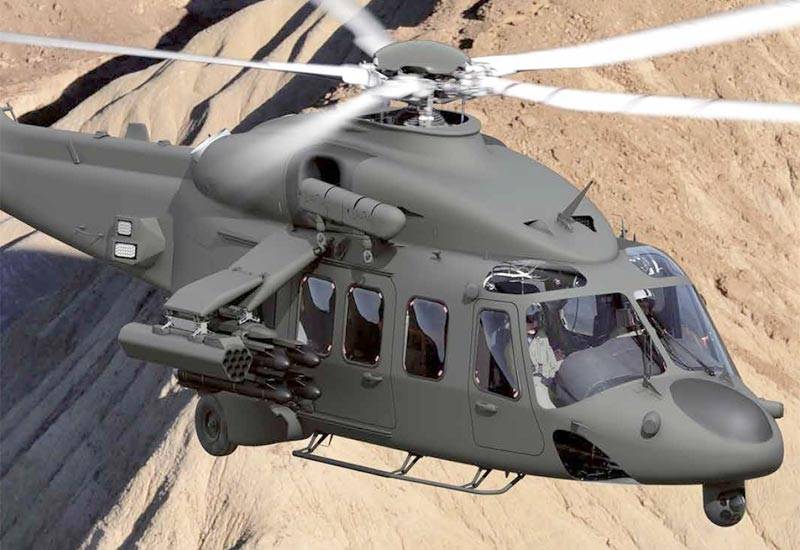
In 2016, Leonardo (formerly Finmeccanica), which now owns the trademark AgustaWestland, proposed the creation of a combat helicopter based on the transport combat AW.149.
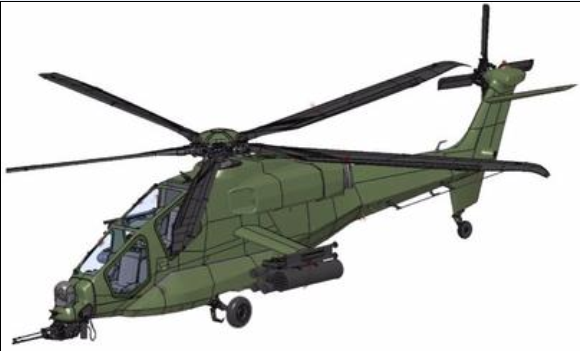
According to the proposed project, the AW.249 helicopter, which looks like an A.129, will become larger in size and will have twice the maximum take-off weight. The new shock machine is supposed to use General Electric CT7-2E1 hp 2000 hp engines, which makes it possible to use efficient booking. Due to increased security and reduced radar and thermal conspicuity, helicopter helicopters will be reduced, and the weight of the combat load will double, reaching the 1800 kg value. The main anti-tank weapon AW249 should be the Israeli anti-tank Spike NLOS. However, many foreign military experts have expressed doubts about the ability of the advanced AW.249 combat helicopter to compete on the international arms market with modernized versions of the American Apache, the French-German Tiger and the Russian Mi-28 and Ka-52.
To be continued ...
Based on:
https://www.globalsecurity.org/military/world/europe/a109.htm
http://www.helistart.com/helicopters/Agusta/A129_Mangusta
http://www.esercito.difesa.it/organizzazione/capo-di-sme/Comando-Forze-Operative-Nord/Divisione-Friuli/Brigata-Aeromobile-Friuli/7-Reggimento-AVES-Vega
https://sobchak.wordpress.com/2011/12/20/composizione-squadrone-elicotteri-italhely-ibis-somalia-1992-94/
http://www.army-technology.com/projects/agusta/
- Linnik Sergey
- Aviation against tanks (part of 1)
Aviation against tanks (part of 2)
Aviation against tanks (part of 3)
Aviation against tanks (part of 4)
Aviation against tanks (part of 5)
Aviation against tanks (part of 6)
Aviation against tanks (part of 7)
Aviation against tanks (part of 8)
Aviation against tanks (part of 9)
Aviation against tanks (part of 10)
Aviation against tanks (part of 11)
Aviation against tanks (part of 12)
Aviation against tanks (part of 13)
Aviation against tanks (part of 14)
Aviation against tanks (part of 15)
Aviation against tanks (part of 16)
Aviation against tanks (part of 17)
Aviation against tanks (part of 18)
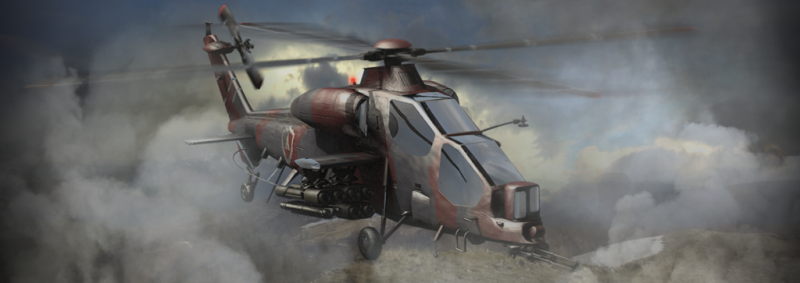
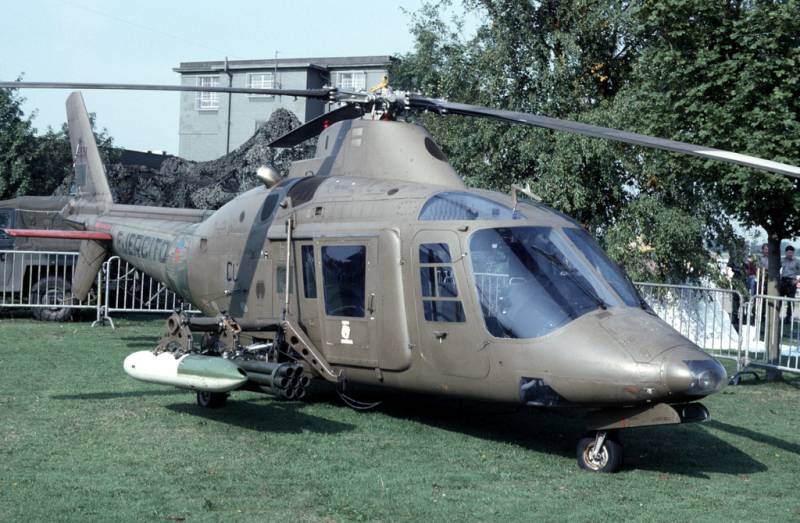
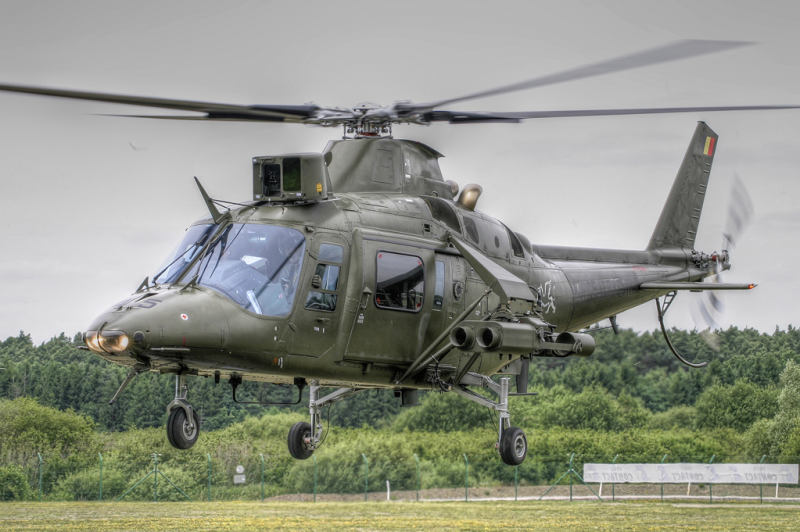
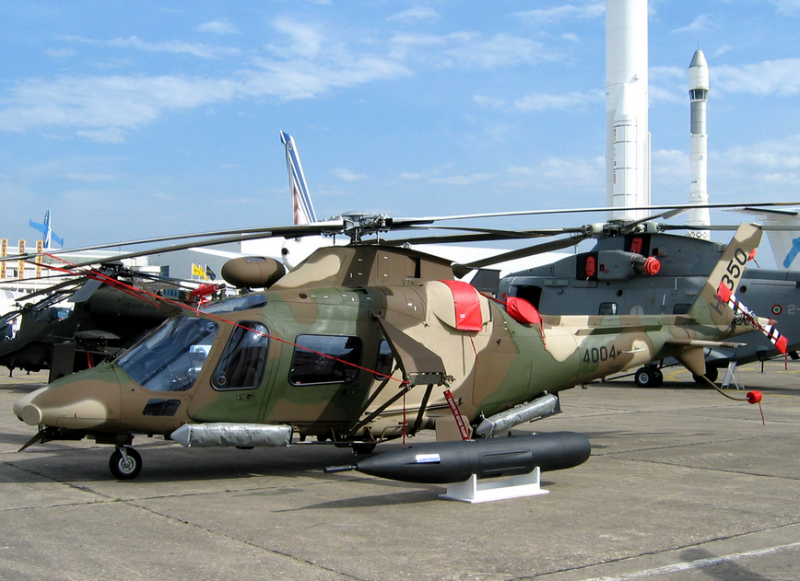
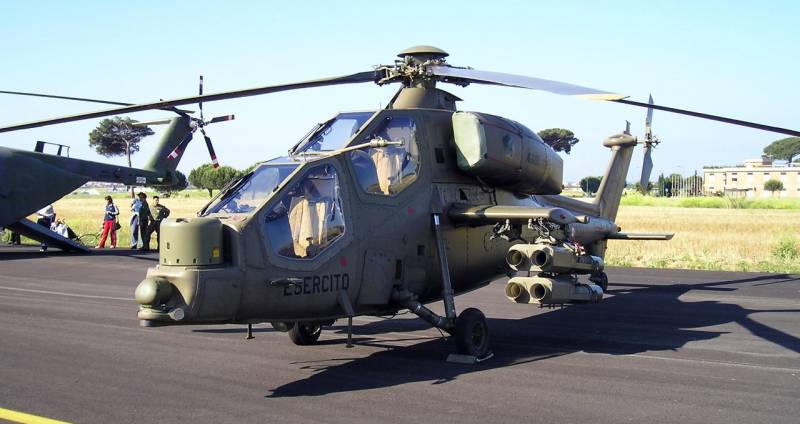
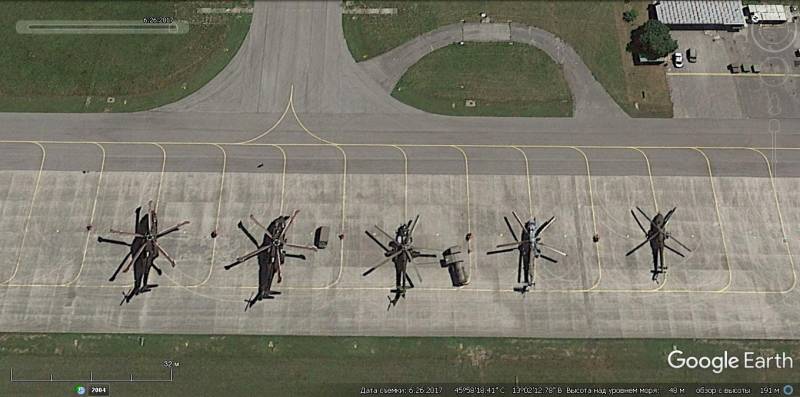
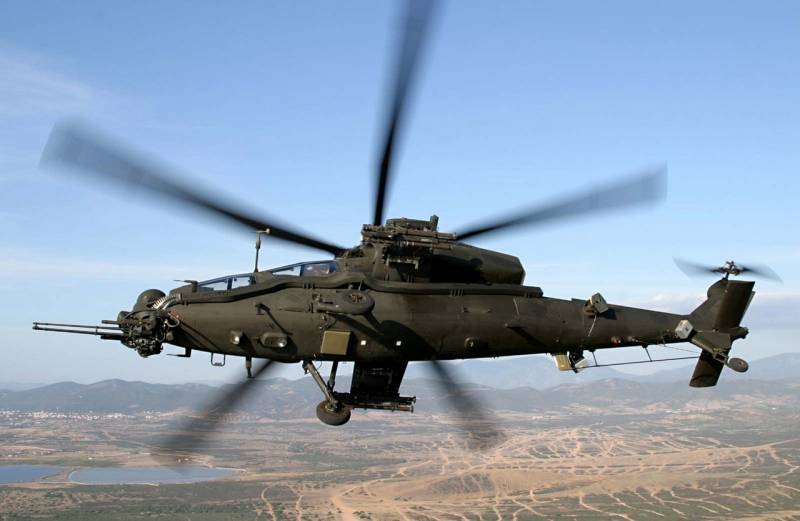
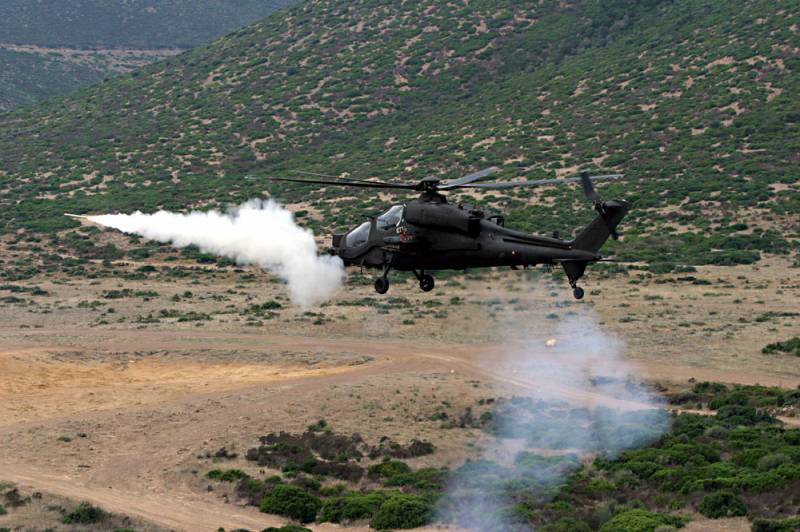
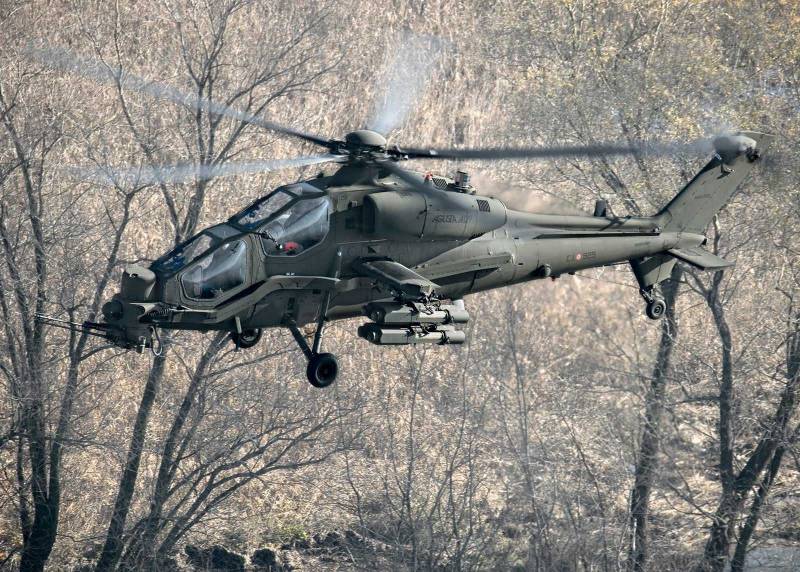
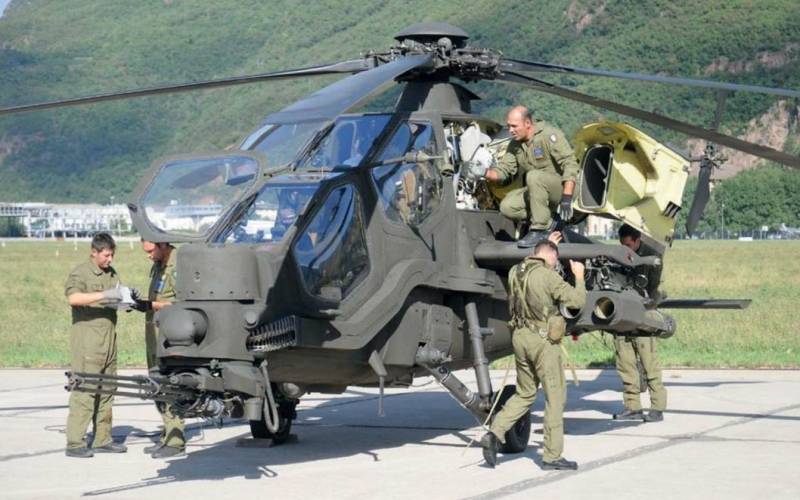
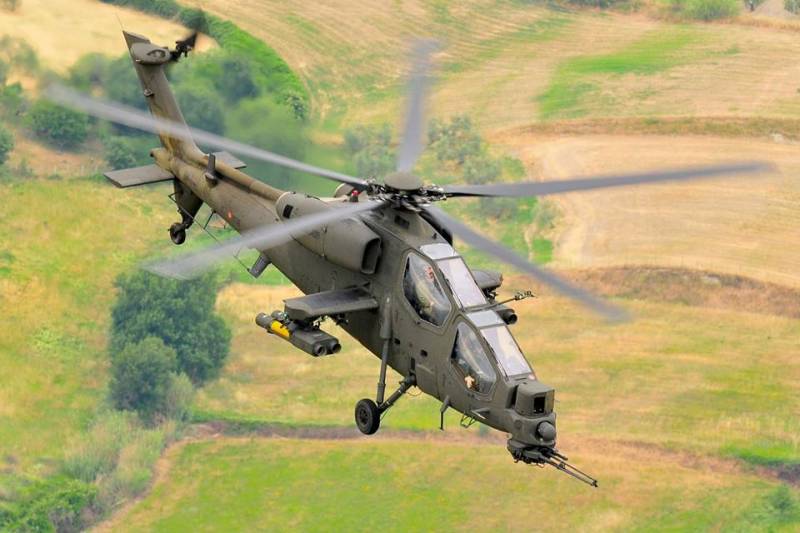
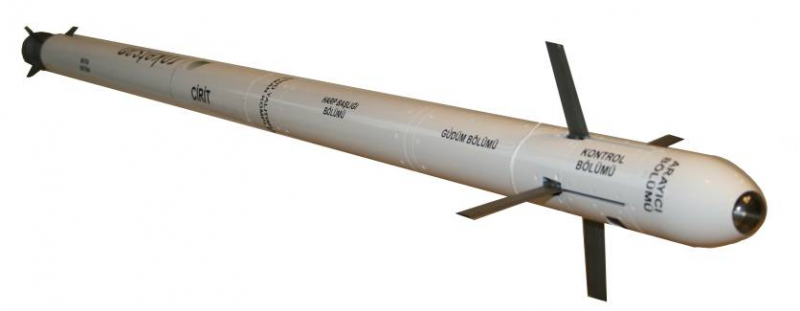
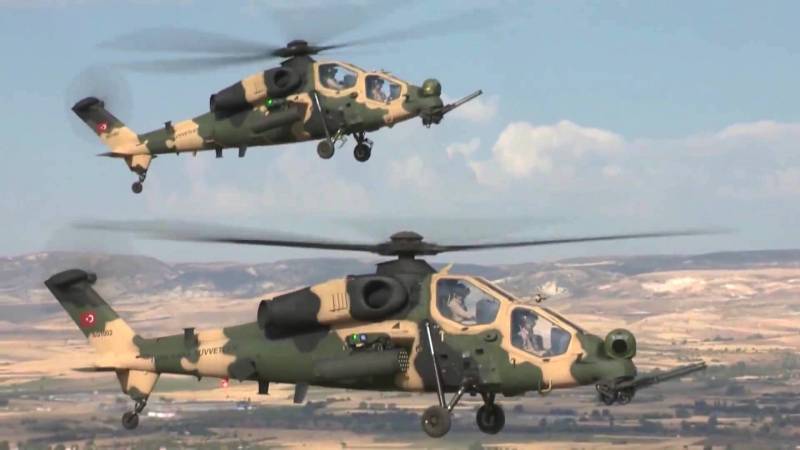
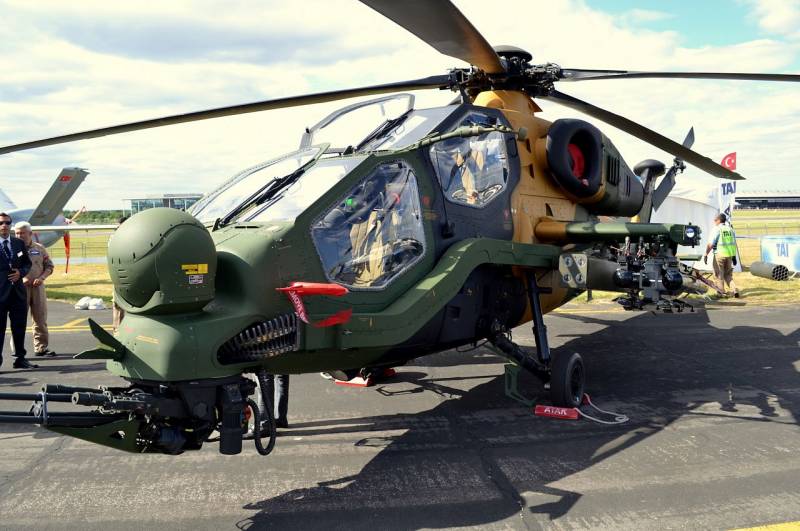
Information